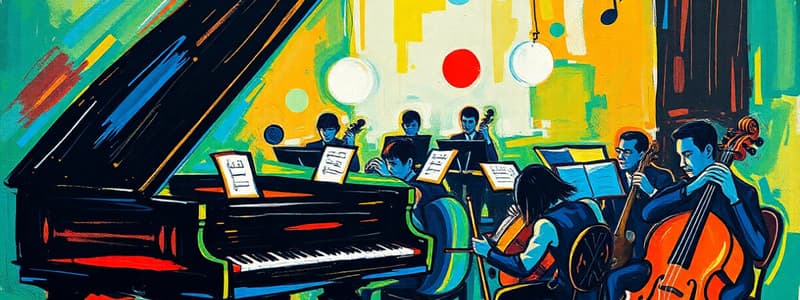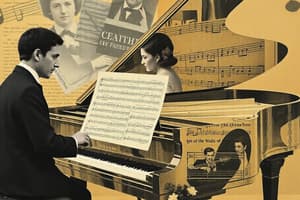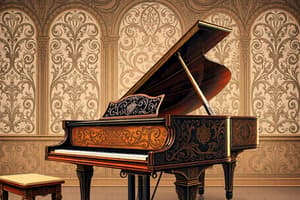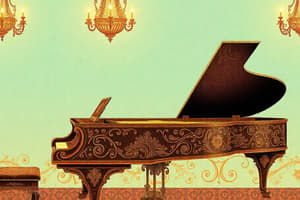Podcast
Questions and Answers
Which innovation significantly enhanced a pianist's ability to play rapid passages on the grand piano?
Which innovation significantly enhanced a pianist's ability to play rapid passages on the grand piano?
- The introduction of the sostenuto pedal.
- The development of the full iron frame.
- The invention of the 'double escapement' action. (correct)
- The use of plastic keys instead of ivory.
A piano student is looking for a grand piano known for its particularly rich and resonant bass tones. Which type of grand piano would be most suitable?
A piano student is looking for a grand piano known for its particularly rich and resonant bass tones. Which type of grand piano would be most suitable?
- A concert grand piano, reaching up to 9 feet 10 inches. (correct)
- A Viennese piano, known for its delicate action.
- A baby grand piano, typically around 5 feet in length.
- An early grand piano housed in a harpsichord case.
In the evolution of keyboard instruments, which sequence accurately represents the progression leading to the grand piano?
In the evolution of keyboard instruments, which sequence accurately represents the progression leading to the grand piano?
- Clavichord → harpsichord → santur → hammered dulcimer.
- Santur → clavichord → harpsichord → grand piano.
- Santur → hammered dulcimer → clavichord/harpsichord → grand piano. (correct)
- Harpsichord → clavichord → hammered dulcimer → santur.
A piano technician is restoring an antique grand piano and discovers that the keys are made of ivory and ebony. Based on typical construction, which keys would be made of ebony?
A piano technician is restoring an antique grand piano and discovers that the keys are made of ivory and ebony. Based on typical construction, which keys would be made of ebony?
A composer wants to write a piano piece that utilizes sustained notes, while allowing other melodic lines to be played without sustain. Which pedal would achieve this effect?
A composer wants to write a piano piece that utilizes sustained notes, while allowing other melodic lines to be played without sustain. Which pedal would achieve this effect?
Why are louder instruments typically positioned behind quieter ones in an orchestra?
Why are louder instruments typically positioned behind quieter ones in an orchestra?
Which of the following describes the most accurate historical progression of the symphony orchestra?
Which of the following describes the most accurate historical progression of the symphony orchestra?
Which instrumental family primarily creates sound through vibrating air within a tube?
Which instrumental family primarily creates sound through vibrating air within a tube?
Considering the general layout of an orchestra, where would one most likely find the tuba?
Considering the general layout of an orchestra, where would one most likely find the tuba?
Which of the following instruments can function both as part of the orchestra and as a solo instrument, particularly in concertos?
Which of the following instruments can function both as part of the orchestra and as a solo instrument, particularly in concertos?
Which of the following best describes Berlioz's primary contribution to the development of the symphony as a musical form?
Which of the following best describes Berlioz's primary contribution to the development of the symphony as a musical form?
Berlioz's Treatise on Instrumentation was significant primarily because it:
Berlioz's Treatise on Instrumentation was significant primarily because it:
In the fourth movement of the Symphonie Fantastique, 'March to the Scaffold', what does the solo clarinet primarily represent?
In the fourth movement of the Symphonie Fantastique, 'March to the Scaffold', what does the solo clarinet primarily represent?
How did Berlioz's personal experiences influence the composition of Symphonie Fantastique?
How did Berlioz's personal experiences influence the composition of Symphonie Fantastique?
How did Berlioz creatively use instruments in the third movement, 'Scene in the Country', from Symphonie Fantastique to evoke a pastoral setting?
How did Berlioz creatively use instruments in the third movement, 'Scene in the Country', from Symphonie Fantastique to evoke a pastoral setting?
Wagner significantly altered opera by emphasizing what concept?
Wagner significantly altered opera by emphasizing what concept?
Which individual provided Wagner with crucial support during his exile and promoted his compositions?
Which individual provided Wagner with crucial support during his exile and promoted his compositions?
What fundamentally important innovation did Wagner introduce to operatic composition?
What fundamentally important innovation did Wagner introduce to operatic composition?
Which of Wagner's operas inspired King Ludwig II to construct the Neuschwanstein Castle?
Which of Wagner's operas inspired King Ludwig II to construct the Neuschwanstein Castle?
What is the central theme of Wagner's Ring Cycle?
What is the central theme of Wagner's Ring Cycle?
Which of the following statements best reflects Mozart's view on the role of music, as described?
Which of the following statements best reflects Mozart's view on the role of music, as described?
How did Wagner use leitmotifs in The Ring Cycle to enhance the narrative?
How did Wagner use leitmotifs in The Ring Cycle to enhance the narrative?
How did the design of the piano, compared to the harpsichord, influence the music composed during Mozart's time?
How did the design of the piano, compared to the harpsichord, influence the music composed during Mozart's time?
Which political movement is most closely associated with the controversial adoption of Wagner's music?
Which political movement is most closely associated with the controversial adoption of Wagner's music?
Considering the societal norms of the 18th century, what was the primary reason Maria Anna Mozart could not pursue a professional music career, despite her talent?
Considering the societal norms of the 18th century, what was the primary reason Maria Anna Mozart could not pursue a professional music career, despite her talent?
What prompted Wagner to initially leave Germany and relocate to Switzerland?
What prompted Wagner to initially leave Germany and relocate to Switzerland?
Which of the following is a key difference between the harpsichord and the piano, impacting the style of music written for each instrument?
Which of the following is a key difference between the harpsichord and the piano, impacting the style of music written for each instrument?
What is the name of the theatre designed and built for Wagner's operas?
What is the name of the theatre designed and built for Wagner's operas?
Which of Mozart's operas blends singing and spoken dialogue, a form known as a singspiel, while depicting a quest aided by magical instruments?
Which of Mozart's operas blends singing and spoken dialogue, a form known as a singspiel, while depicting a quest aided by magical instruments?
How did Mozart's professional life in Salzburg contribute to his eventual move to Vienna?
How did Mozart's professional life in Salzburg contribute to his eventual move to Vienna?
Considering Mozart's lifespan and prolific output, what can be inferred about his compositional process?
Considering Mozart's lifespan and prolific output, what can be inferred about his compositional process?
How did the role of musicians and composers change during the Classical era compared to previous periods?
How did the role of musicians and composers change during the Classical era compared to previous periods?
What is the significance of the 'Sonata form' in the Classical era?
What is the significance of the 'Sonata form' in the Classical era?
Which characteristic is NOT typically associated with Classical music?
Which characteristic is NOT typically associated with Classical music?
Which composer is known for establishing the symphony and the four-part string quartet?
Which composer is known for establishing the symphony and the four-part string quartet?
How did Christoph Willibald Gluck contribute to the evolution of opera?
How did Christoph Willibald Gluck contribute to the evolution of opera?
What was the significance of the Age of Enlightenment in the context of the Classical era?
What was the significance of the Age of Enlightenment in the context of the Classical era?
Which composer was known as the 'English Mozart'?
Which composer was known as the 'English Mozart'?
How did C.P.E. Bach contribute to the transition between the Baroque and Classical periods?
How did C.P.E. Bach contribute to the transition between the Baroque and Classical periods?
What innovation is attributed to Jan Ladislav Dussek?
What innovation is attributed to Jan Ladislav Dussek?
Flashcards
Grand Piano
Grand Piano
A large piano with a wide range of notes, over seven octaves.
History of Grand Pianos
History of Grand Pianos
Evolution from santur to hammered dulcimer, then to clavichord and grand piano by 1777.
Piano Range
Piano Range
Different sizes of grand pianos, from baby grands to concert grands, affecting sound quality.
Piano Anatomy
Piano Anatomy
Signup and view all the flashcards
Famous Pianists
Famous Pianists
Signup and view all the flashcards
Symphony Orchestra
Symphony Orchestra
Signup and view all the flashcards
String Instruments
String Instruments
Signup and view all the flashcards
Woodwind Instruments
Woodwind Instruments
Signup and view all the flashcards
Brass Instruments
Brass Instruments
Signup and view all the flashcards
Percussion Instruments
Percussion Instruments
Signup and view all the flashcards
Hector Berlioz
Hector Berlioz
Signup and view all the flashcards
Symphonie Fantastique
Symphonie Fantastique
Signup and view all the flashcards
Program Music
Program Music
Signup and view all the flashcards
Orchestration
Orchestration
Signup and view all the flashcards
Movements of Symphonie Fantastique
Movements of Symphonie Fantastique
Signup and view all the flashcards
Richard Wagner
Richard Wagner
Signup and view all the flashcards
The Ring Cycle
The Ring Cycle
Signup and view all the flashcards
Lohengrin
Lohengrin
Signup and view all the flashcards
Leitmotifs
Leitmotifs
Signup and view all the flashcards
Tristan und Isolde
Tristan und Isolde
Signup and view all the flashcards
Influence of Beethoven
Influence of Beethoven
Signup and view all the flashcards
Exile to Switzerland
Exile to Switzerland
Signup and view all the flashcards
Bayreuth Festival
Bayreuth Festival
Signup and view all the flashcards
Controversy with Hitler
Controversy with Hitler
Signup and view all the flashcards
Wolfgang Amadeus Mozart
Wolfgang Amadeus Mozart
Signup and view all the flashcards
Mozart's Operas
Mozart's Operas
Signup and view all the flashcards
The Marriage of Figaro
The Marriage of Figaro
Signup and view all the flashcards
The Magic Flute
The Magic Flute
Signup and view all the flashcards
Piano Functioning
Piano Functioning
Signup and view all the flashcards
Harpsichord vs. Piano
Harpsichord vs. Piano
Signup and view all the flashcards
Influences on Mozart
Influences on Mozart
Signup and view all the flashcards
Classical Music Period
Classical Music Period
Signup and view all the flashcards
Age of Enlightenment
Age of Enlightenment
Signup and view all the flashcards
Sonata Form
Sonata Form
Signup and view all the flashcards
Alessandro Scarlatti
Alessandro Scarlatti
Signup and view all the flashcards
Franz Joseph Haydn
Franz Joseph Haydn
Signup and view all the flashcards
C.P.E. Bach
C.P.E. Bach
Signup and view all the flashcards
Christoph Willibald Gluck
Christoph Willibald Gluck
Signup and view all the flashcards
Luigi Boccherini
Luigi Boccherini
Signup and view all the flashcards
Johann Christian Bach
Johann Christian Bach
Signup and view all the flashcards
Study Notes
Grand Piano History
- According to tradition, the piano evolved from the harpsichord in the 1700s.
- The first written record of the harpsichord-that-was-strung-instrument is from 1300.
- 1500-1700s: Harpsichord and other Baroque instruments were popular in Europe.
- c. 1700: Rich Italian Medici family owned the piano.
- Late 1700s: Johann Andreas Stein invented an improved version of the piano called the Viennese piano.
- 1777: Bartolomeo Cristofori invented the pianoforte.
- 1800s: Double-action instrument for playing extremely fast.
- 1837: First full iron frame for the piano.
- 1853: Steinway & Sons set up a prestigious piano company.
- Grand pianos come in several sizes, starting with 4ft 4 in (162 cm) which are smaller in length, and ending with the concert grand, which can be up to 9 ft 10 in (3 m) long.
- The larger the piano, especially bass strings giving the concert grand piano a rich tone and resonance.
Grand Piano Function
- The piano is able to communicate the subtleties of universal truths by means of wood, metal, and vibrating air.
- Known as the "king of instruments," the piano has the widest range of notes in any instrument, covering more than seven octaves.
- The word "piano" is short for pianoforte, meaning that the instrument can be played both softly (piano) and loudly (forte) in response to the player's touch on the keyboard.
- The strings are held under tension by an iron frame.
- The black keys are traditionally made of ebony wood, while the white keys are made of ivory.
- The keyboard is made up of white and black keys.
- The soft pedal makes the notes played softer, which allows the notes played to continue but the sound normal.
- The damper or the sustain pedal makes the notes continue to sound.
Top Pianists
- Many Classical and Romantic piano works were composed by brilliant pianists, such as Wolfgang Amadeus Mozart, Ludwig van Beethoven, Franz Liszt, Frédéric Chopin, and Clara Schumann.
- There have been quite a lot of composers who created music for the piano over the last 300 years.
Studying That Suits You
Use AI to generate personalized quizzes and flashcards to suit your learning preferences.





